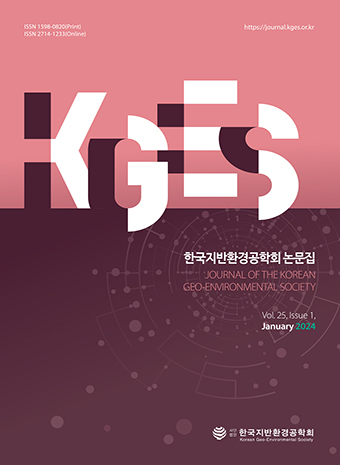Instructions to Authors
1. Manuscript preparation
1.1 Software and Paper
Your manuscript shall be written on the A4-size paper using Hangul or MS-word.
1.2 Font and Spacing
The font of text is recommended to use Sinmyungcho in 9.5 size and 170% of spacing basically.
2. Manuscript Format
The manuscript format should follow the order below;
(1) Title (Korean and English followed in Korean manuscript, English only in English manuscript.)
(2) Author(s) (Korean and English followed in Korean manuscript, English only in English manuscript.)
(3) Affiliation and personal title (Both in Korean and in English)
(4) Abstract (Korean and English followed in Korean manuscript, English only in English manuscript.)
(5) Keywords
(6) Body
(7) Acknowledgement (if needed)
(8) References
(9) Symbols and units (Greek symbols, English symbols in alphabetical order)(if needed)
(10) Appendix (if needed)
3. Title of manuscript
(1) The title of manuscript should be concise and informative and the sub-title can be used if necessary.
(2) For the manuscript in Korean, the title in English should be followed immediately after the title in Korean. For the manuscript in English, leave the title in English only.
(3) For the tile In English, the first letter of the sentence and vocabulary should be in a capital letter. The preposition, definite/indefinite article, and conjunction used in the sentence should be a lowercase(refer to the example below).
Example Line spacing : 130%, Centered
(크기 18)
The Removal of Humic Acid and Heavy Metals Using UV/TiO2/H2O2
(Font 16, Block)
4. Name of Author
(1) English name after Korean name should be written in Korean manuscript.
(2) Do not write Korean name in English manuscript.
Example Line spacing : 160%, Centered
(크기 10.5)
Gildong Hong ・ Gyun Huh ・ Yulgok Lee
(Font 10.5)
(3) The author's personal title and affiliation should be displayed by 1), 2) in the footnote in the first page of the manuscript (The corresponding author is displayed with † and the email address should be provided).
Example Line spacing : 140% (Font 8)
2) Member, Department of Civil Engineering, Hankuk University
† Professor, Department of Civil Engineering, Hankuk University (Corresponding Author : yglee@hanguk.ac.kr)
The abstract should be marked as 'Abstract' and written in Korean and English within 150~200 words.
Example Line spacing : 140%
(Font 8.5)
In this study, the geo-engineering applicability of the pervious wall which has a function of permeability after purification in the landfill site is evaluated to replace barrier wall which functions as a physical barrier only.
6. Keywords
4-6 keywords following the abstract should be presented and the first letter of each keyword should be written by a capital letter.
Example
7. Body(Section and subsection)
The section and subsection should be divided as shown in example below.
Example
3.1 Simultaneous removal of humic acid and heavy metals (Font 11)
3.1.1 Efficiency of humic acid and heavy metals removal (Font 10)
8. Tables, Figures
(1) The tables and figures should be consecutively numbered and be properly located in the text.
(2) The title of the table should be written in English. The first letter of the title is capitalized.
Example
(3) The title of the figure should be written in English. The first letter of the title is capitalized.
Example
9. Unit
It is desirable that units of measurements and abbreviation should follow The International System of Units(SI) except where the other unit system is more suitable with the parenthesis.
10. Reference citation
When the reference is cited in the text, the author and publication year should be written with parenthesis (e.g., (Yamada, 1977)). When the sentence starts with the author of the reference in the text, only the publication year should be written with the parenthesis (e.g., Hong Gil Dong(1986)). In case two or more references by one author are in same issued year, it should be differentiated by ‘a’, ‘b’ … behind the issued year. If there are several references for same citation, the references are differentiated by (;).
The full-name should be displayed when the Korean references are cited whereas only the last name should be displayed for the reference in English. For two authors, both authors should be displayed. For more than 3 authors, the first author only should be displayed such as “Yen et al.”. The following example shows the usage of spacing and punctuation.
Example
11. References
11.1 References list
The references should be written in English in alphabetical order. For the reference in Korean, it should be marked with (in Korean), for the reference in Japanese, it should be marked with (in Japanese). If it is impossible to write the reference in English, the reference should be listed in order of Korean, Japanese and other languages.
The Korean references should be arranged in order of 'Ga, Na, Da' of author's name, for Japanese reference, in 50 notes, for English and other languages, in alphabetical order. In case of Japanese reference written in Chinese letter, it should be displayed in order of 'Ga, Na, Da'. If the first author's name is same, it should be listed in order of the second author's name. The reference without the second author comes in first. In case of 3 or more authors, it should be listed in the same way. If the author's name is same, the references should be listed in order of publication year. If the publication year is same, it should be listed by title in 'Ga, Na, Da'(alphabetical) order.
11.2 References declare
① Journal article : Number, Author(Issued year), Title, Journal, Issuer(Abroad), Volume, No., Page
Example
2. Robertson, A. P. and Leckie, J. O. (1999), Acid/base, copper binding and Cu2+/H+ exchange properties of a soil humic acid, an experimental and modeling study, Environmental Science and Technology, Vol. 33, No. 6, pp. 786~795.
② Article in conference journal: Number, Author(Issued year), Title, Journal, Issuer(Publisher), Venue(abroad), Volume, Page
Example
4. Hsu, G. J.(1980), On the correction of oceanographic applications. Proceedings of 17th International Conference of Coastal Engineering, ASCE, Sydney, Australia, pp. 709~724.
5. Wang, H. T.(1985), Temporal and spatial simulations of random ocean waves, Proceedings of 4th International Offshore Mechanics and Arctic Engineering Symposium, American Society of Mechanical Engineers, New York, Vol. 1, pp. 72~80.
③ Article in single book : Number, Author(Issued year), Title, Book, Editor, Volume(if any), Issuer(Publisher), Pub. Place(Abroad), Page
Example
7. Lewellen, W. S.(1977), Use of invariant modelling, Handbook of Turbulence, Frost W., ed., Vol. 1, Plenum Press, New York, N.Y., pp. 237~280.
④ Book : Number, Author(Issued year), Book, Publisher, Pub. Place(Abroad), Page (If the book has no English, it can be marked in original language.)
Example
9. Norris, C. H. and Wibur, J. B.(1960), Elementary structural analysis, McGraw-Hill, N.Y. pp. 250~255.
⑤ Dissertation : Number, Author(Granted year), Title, Degree, Institution, Place(Abroad), Page
Example
11. Beltaos, S.(1974), Turbulent impinging jets, Ph D. dissertation, University of Alberta, Edmonton, Alberta, Canada, pp. 250~258.
⑥ Report : Number, Author(Issued year), Title, Classification(No.), Laboratory, Place(Abroad), Page. (If the report has no English, it can be marked in original language.)
Example
12. Edinger, J. E., Brady, D. K. and Geyer, J. C.(1974), Heat exchange and transport in the environment. Report 14, EPRI Publication No. 74-049-00-3, Electric Power Res. Inst., Palo Alto, Calif., pp. 83~85.
13. Kananbolo, D. C. and Norville, H. S.(1995), The strength of new window glass plates using surface characteristics, Report, Glass Research and Testing Laboratory, Texas Tech University, Lubbock, Tex., pp. 256~259.
The symbols in manuscript should have the accurate definition and should be listed in order of Greek, English alphabetically.


 Journal of the Korean Geo-Environmental Society
Journal of the Korean Geo-Environmental Society





